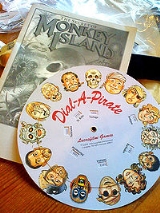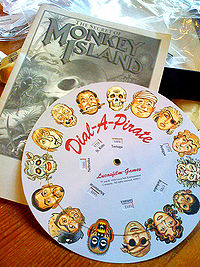
Code wheel
Encyclopedia
A code wheel is a type of copy protection
used on older computer games, often those published in the late 1980s and early 1990s. It evolved from the original "manual protection" system in which the program would require the user to enter a specific word from the manual before the game would start up or continue beyond a certain point. This system was popular because it allowed the actual media to be backed up and replaced freely while retaining security, but with the increased availability of photocopiers, pirates simply started copying the manuals along with the games to defeat the measure.
Although whole code wheels could not be directly photocopied, the component wheels could be disassembled and individually photocopied; these components could then be crafted together into a duplicate wheel. The contents of code wheels could also be copied onto paper and the user of a pirated copy could simply apply a mathematical formula to the presented challenges to calculate the correct response. Once a suitable formula was found, code wheels actually made the process of copying easier since the amount of information they could contain was low compared to a manual of potentially unlimited size. Thus, code wheels were rapidly phased out in favor of regular manual protection and protection based around color, as public access to color photocopying at the time was expensive and uncommon. This was itself made obsolete by a return to protection based on the game media itself, when CD-ROM
s were introduced.
 A code wheel itself is a physical object consisting of several circular sheets of paper or card of different sizes, fastened in the center, creating a set of concentric circles. The game issues the user with a set of challenges (symbols, words, or other identifiers), which instruct the user in how to manipulate the wheel in order to reveal a response, a single symbol or word that the user must enter in order to start the game. Entering anything other than the expected response would result in the game halting or performing other behaviour associated with unauthorised usage of the software (for example, the game Starflight
A code wheel itself is a physical object consisting of several circular sheets of paper or card of different sizes, fastened in the center, creating a set of concentric circles. The game issues the user with a set of challenges (symbols, words, or other identifiers), which instruct the user in how to manipulate the wheel in order to reveal a response, a single symbol or word that the user must enter in order to start the game. Entering anything other than the expected response would result in the game halting or performing other behaviour associated with unauthorised usage of the software (for example, the game Starflight
would send unbeatable "police ships" to destroy the player's spaceship).
).
game Rocket Ranger
, the player turned the wheel to match their Ranger's current location, then read a value from the hole corresponding to the location where they wanted to fly to. The holes were in a simple column. Since this was the only mechanism for the player to specify where they wanted to fly, it was impossible for crackers to remove it from the game without destroying the entire gameplay.
and The Fool's Errand
, retained the back wheel with printed responses and the front wheel with holes, and added further "middle" wheels between the front and back which contained a mixture of printed responses and further holes that allowed the next wheel to show through when particular challenge symbols were aligned
Copy protection
Copy protection, also known as content protection, copy obstruction, copy prevention and copy restriction, refer to techniques used for preventing the reproduction of software, films, music, and other media, usually for copyright reasons.- Terminology :Media corporations have always used the term...
used on older computer games, often those published in the late 1980s and early 1990s. It evolved from the original "manual protection" system in which the program would require the user to enter a specific word from the manual before the game would start up or continue beyond a certain point. This system was popular because it allowed the actual media to be backed up and replaced freely while retaining security, but with the increased availability of photocopiers, pirates simply started copying the manuals along with the games to defeat the measure.
Although whole code wheels could not be directly photocopied, the component wheels could be disassembled and individually photocopied; these components could then be crafted together into a duplicate wheel. The contents of code wheels could also be copied onto paper and the user of a pirated copy could simply apply a mathematical formula to the presented challenges to calculate the correct response. Once a suitable formula was found, code wheels actually made the process of copying easier since the amount of information they could contain was low compared to a manual of potentially unlimited size. Thus, code wheels were rapidly phased out in favor of regular manual protection and protection based around color, as public access to color photocopying at the time was expensive and uncommon. This was itself made obsolete by a return to protection based on the game media itself, when CD-ROM
CD-ROM
A CD-ROM is a pre-pressed compact disc that contains data accessible to, but not writable by, a computer for data storage and music playback. The 1985 “Yellow Book” standard developed by Sony and Philips adapted the format to hold any form of binary data....
s were introduced.
Code wheel forms

Starflight
Starflight is a computer game published by Electronic Arts and developed by Binary Systems in 1986. Originally developed for DOS and Tandy, it was later released for the Amiga, Atari ST, Macintosh and Commodore 64...
would send unbeatable "police ships" to destroy the player's spaceship).
2-ply
A simple 2-ply code wheel consisted of two circular sheets, both with challenge symbols printed at intervals around the rim, and with the back sheet containing a table of responses printed to fit to the circle, and the front sheet a series of holes allowing the responses to be viewed, each hole labelled with a challenge symbol. The computer would present three challenge symbols, and the user would read the response by rotating the front sheet until the first two challenge symbols were aligned with each other on the rim of the wheel, then read the response from the hole indicated by the third challenge symbol. This type of codewheel was used for a large number of games, such as Neuromancer, and Cybercon 3 (which used a code wheel printed on carbon paperCarbon paper
Carbon paper is paper coated on one side with a layer of a loosely bound dry ink or pigmented coating, usually bound with wax. It is used for making one or more copies simultaneous with the creation of an original document...
).
Single-ply
There was one usage of a single-ply code wheel, where only two challenge symbols were used; in the AmigaAmiga
The Amiga is a family of personal computers that was sold by Commodore in the 1980s and 1990s. The first model was launched in 1985 as a high-end home computer and became popular for its graphical, audio and multi-tasking abilities...
game Rocket Ranger
Rocket Ranger
Rocket Ranger is a 1988 action adventure computer game developed and published by Cinemaware. The game is set in an alternate history World War II where Nazi scientists are about to make an astonishing breakthrough that will allow them to win the war...
, the player turned the wheel to match their Ranger's current location, then read a value from the hole corresponding to the location where they wanted to fly to. The holes were in a simple column. Since this was the only mechanism for the player to specify where they wanted to fly, it was impossible for crackers to remove it from the game without destroying the entire gameplay.
3-ply
A 3-ply code wheel, used in games such as Star ControlStar Control
Star Control is a science fiction computer game that was developed by Toys for Bob and published by Accolade in the early 1990s. Star Control still enjoys a cult following...
and The Fool's Errand
The Fool's Errand
The Fool's Errand is a 1987 computer game by Cliff Johnson. It is a meta-puzzle game with storytelling, visual puzzles and a cryptic treasure map...
, retained the back wheel with printed responses and the front wheel with holes, and added further "middle" wheels between the front and back which contained a mixture of printed responses and further holes that allowed the next wheel to show through when particular challenge symbols were aligned
In popular media
- The webcomic Penny ArcadePenny Arcade (webcomic)Penny Arcade is a webcomic focused on video games and video game culture, written by Jerry Holkins and illustrated by Mike Krahulik. The comic debuted in 1998 on the website loonygames.com. Since then, Holkins and Krahulik have established their own site, which is typically updated with a new comic...
references code wheels in a comic strip published September 26, 2008.

